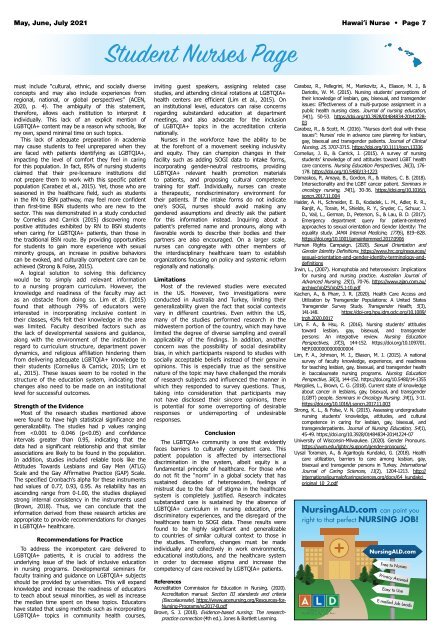Hawaii Nurse - May 2021
You also want an ePaper? Increase the reach of your titles
YUMPU automatically turns print PDFs into web optimized ePapers that Google loves.
<strong>May</strong>, June, July <strong>2021</strong> Hawaiʻi <strong>Nurse</strong> • Page 7<br />
Student <strong>Nurse</strong>s Page<br />
must include “cultural, ethnic, and socially diverse<br />
concepts and may also include experiences from<br />
regional, national, or global perspectives” (ACEN,<br />
2020, p. 4). The ambiguity of this statement,<br />
therefore, allows each institution to interpret it<br />
individually. This lack of an explicit mention of<br />
LGBTQIA+ content may be a reason why schools, like<br />
my own, spend minimal time on such topics.<br />
This lack of adequate preparation in academia<br />
may cause students to feel unprepared when they<br />
are faced with patients identifying as LGBTQIA+,<br />
impacting the level of comfort they feel in caring<br />
for this population. In fact, 85% of nursing students<br />
claimed that their pre-licensure institutions did<br />
not prepare them to work with this specific patient<br />
population (Carabez et al., 2015). Yet, those who are<br />
seasoned in the healthcare field, such as students<br />
in the RN to BSN pathway, may feel more confident<br />
than first-time BSN students who are new to the<br />
sector. This was demonstrated in a study conducted<br />
by Cornelius and Carrick (2015) discovering more<br />
positive attitudes exhibited by RN to BSN students<br />
when caring for LGBTQIA+ patients, than those in<br />
the traditional BSN route. By providing opportunities<br />
for students to gain more experience with sexual<br />
minority groups, an increase in positive behaviors<br />
can be evoked, and culturally competent care can be<br />
achieved (Strong & Folse, 2015).<br />
A logical solution to solving this deficiency<br />
would be to simply add relevant information<br />
to a nursing program curriculum. However, the<br />
knowledge and readiness of the faculty may act<br />
as an obstacle from doing so. Lim et al. (2015)<br />
found that although 79% of educators were<br />
interested in incorporating inclusive content in<br />
their classes, 43% felt their knowledge in the area<br />
was limited. Faculty described factors such as<br />
the lack of developmental sessions and guidance,<br />
along with the environment of the institution in<br />
regard to curriculum structure, department power<br />
dynamics, and religious affiliation hindering them<br />
from delivering adequate LGBTQIA+ knowledge to<br />
their students (Cornelius & Carrick, 2015; Lim et<br />
al., 2015). These issues seem to be rooted in the<br />
structure of the education system, indicating that<br />
changes also need to be made on an institutional<br />
level for successful outcomes.<br />
Strength of the Evidence<br />
Most of the research studies mentioned above<br />
were found to have high statistical significance and<br />
generalizability. The studies had p values ranging<br />
from

















